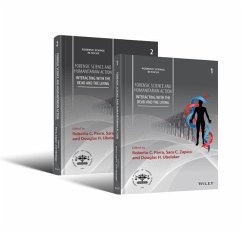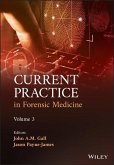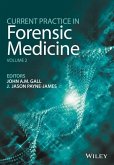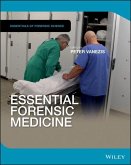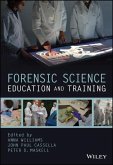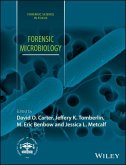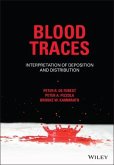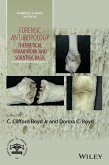Forensic Science and Humanitarian Action, 2 Volume Set
Interacting with the Dead and the Living
Herausgegeben:Parra, Roberto C.; Zapico, Sara C.; Ubelaker, Douglas H.
Forensic Science and Humanitarian Action, 2 Volume Set
Interacting with the Dead and the Living
Herausgegeben:Parra, Roberto C.; Zapico, Sara C.; Ubelaker, Douglas H.
- Gebundenes Buch
- Merkliste
- Auf die Merkliste
- Bewerten Bewerten
- Teilen
- Produkt teilen
- Produkterinnerung
- Produkterinnerung
Widens traditional concepts of forensic science to include humanitarian, social, and cultural aspects
Using the preservation of the dignity of the deceased as its foundation, Forensic Science and Humanitarian Action: Interacting with the Dead and the Living is a unique examination of the applications of humanitarian forensic science. Spanning two comprehensive volumes, the text is sufficiently detailed for forensic practitioners, yet accessible enough for non-specialists, and discusses both the latest technologies and real-world interactions. Arranged into five sections, this book addresses…mehr
Andere Kunden interessierten sich auch für
![Current Practice in Forensic Medicine, Volume 3 Current Practice in Forensic Medicine, Volume 3]() Current Practice in Forensic Medicine, Volume 3152,99 €
Current Practice in Forensic Medicine, Volume 3152,99 €![Current Practice in Forensic Medicine, Volume 2 Current Practice in Forensic Medicine, Volume 2]() Current Practice in Forensic Medicine, Volume 2133,99 €
Current Practice in Forensic Medicine, Volume 2133,99 €![Essential Forensic Medicine Essential Forensic Medicine]() Peter VanezisEssential Forensic Medicine108,99 €
Peter VanezisEssential Forensic Medicine108,99 €![Forensic Science Education and Training Forensic Science Education and Training]() Forensic Science Education and Training117,99 €
Forensic Science Education and Training117,99 €![Forensic Microbiology Forensic Microbiology]() Forensic Microbiology149,99 €
Forensic Microbiology149,99 €![Blood Traces Blood Traces]() Peter R. De ForestBlood Traces159,99 €
Peter R. De ForestBlood Traces159,99 €![Forensic Anthropology Forensic Anthropology]() Forensic Anthropology168,99 €
Forensic Anthropology168,99 €-
-
-
Widens traditional concepts of forensic science to include humanitarian, social, and cultural aspects
Using the preservation of the dignity of the deceased as its foundation, Forensic Science and Humanitarian Action: Interacting with the Dead and the Living is a unique examination of the applications of humanitarian forensic science. Spanning two comprehensive volumes, the text is sufficiently detailed for forensic practitioners, yet accessible enough for non-specialists, and discusses both the latest technologies and real-world interactions. Arranged into five sections, this book addresses the 'management of the dead' across five major areas in humanitarian forensic science.
Volume One presents the first three of these areas: History, Theory, Practice, and Legal Foundation; Basic Forensic Information to Trace Missing Persons; and Stable Isotopes Forensics. Topics covered include:
_ Protection of The Missing and the Dead Under International Law
_ Social, Cultural and Religious Factors in Humanitarian Forensic Science
_ Posthumous Dignity and the Importance in Returning Remains of the Deceased
_ The New Disappeared - Migration and Forensic Science
_ Stable Isotope Analysis in Forensic Anthropology
Volume Two covers two further areas of interest: DNA Analysis and the Forensic Identification Process. It concludes with a comprehensive set of case studies focused on identifying the deceased, and finding missing persons from around the globe, including:
_ Forensic Human Identification from an Australian Perspective
_ Skeletal Remains and Identification Processing at the FBI
_ Migrant Deaths along the Texas/Mexico Border
_ Humanitarian Work in Cyprus by The Committee on Missing Persons (CMP)
_ Volcán De Fuego Eruption - Natural Disaster Response from Guatemala
Drawing upon a wide range of contributions from respected academics working in the field, Forensic Science and Humanitarian Action is a unique reference for forensic practitioners, communities of humanitarian workers, human rights defenders, and government and non-governmental officials.
Hinweis: Dieser Artikel kann nur an eine deutsche Lieferadresse ausgeliefert werden.
Using the preservation of the dignity of the deceased as its foundation, Forensic Science and Humanitarian Action: Interacting with the Dead and the Living is a unique examination of the applications of humanitarian forensic science. Spanning two comprehensive volumes, the text is sufficiently detailed for forensic practitioners, yet accessible enough for non-specialists, and discusses both the latest technologies and real-world interactions. Arranged into five sections, this book addresses the 'management of the dead' across five major areas in humanitarian forensic science.
Volume One presents the first three of these areas: History, Theory, Practice, and Legal Foundation; Basic Forensic Information to Trace Missing Persons; and Stable Isotopes Forensics. Topics covered include:
_ Protection of The Missing and the Dead Under International Law
_ Social, Cultural and Religious Factors in Humanitarian Forensic Science
_ Posthumous Dignity and the Importance in Returning Remains of the Deceased
_ The New Disappeared - Migration and Forensic Science
_ Stable Isotope Analysis in Forensic Anthropology
Volume Two covers two further areas of interest: DNA Analysis and the Forensic Identification Process. It concludes with a comprehensive set of case studies focused on identifying the deceased, and finding missing persons from around the globe, including:
_ Forensic Human Identification from an Australian Perspective
_ Skeletal Remains and Identification Processing at the FBI
_ Migrant Deaths along the Texas/Mexico Border
_ Humanitarian Work in Cyprus by The Committee on Missing Persons (CMP)
_ Volcán De Fuego Eruption - Natural Disaster Response from Guatemala
Drawing upon a wide range of contributions from respected academics working in the field, Forensic Science and Humanitarian Action is a unique reference for forensic practitioners, communities of humanitarian workers, human rights defenders, and government and non-governmental officials.
Hinweis: Dieser Artikel kann nur an eine deutsche Lieferadresse ausgeliefert werden.
Produktdetails
- Produktdetails
- Forensic Science in Focus
- Verlag: Wiley / Wiley & Sons
- Artikelnr. des Verlages: 1W119481960
- 1. Auflage
- Seitenzahl: 896
- Erscheinungstermin: 9. März 2020
- Englisch
- Abmessung: 269mm x 191mm x 58mm
- Gewicht: 2540g
- ISBN-13: 9781119481966
- ISBN-10: 1119481961
- Artikelnr.: 57828924
- Herstellerkennzeichnung
- Libri GmbH
- Europaallee 1
- 36244 Bad Hersfeld
- gpsr@libri.de
- Forensic Science in Focus
- Verlag: Wiley / Wiley & Sons
- Artikelnr. des Verlages: 1W119481960
- 1. Auflage
- Seitenzahl: 896
- Erscheinungstermin: 9. März 2020
- Englisch
- Abmessung: 269mm x 191mm x 58mm
- Gewicht: 2540g
- ISBN-13: 9781119481966
- ISBN-10: 1119481961
- Artikelnr.: 57828924
- Herstellerkennzeichnung
- Libri GmbH
- Europaallee 1
- 36244 Bad Hersfeld
- gpsr@libri.de
Edited by Roberto C. Parra is Forensic Specialist to the Human Rights Office of the High Commissioner (OHCHR), United Nations; and Bioarchaeology and Stable Isotope Research Laboratory, Vanderbilt University, Nashville, Tennessee, USA. Sara C. Zapico is Research Collaborator in the Anthropology Department at Florida International University, International Forensic Research Institute, Miami, USA. Douglas H. Ubelaker is Curator and Senior Scientist in the Department of Anthropology at the National Museum of Natural History, Smithsonian Institution, in Washington, DC, USA.
Section I: History, theory, practice and legal foundation 1. Using forensic science to care for the dead and search for the missing: In conversation with Morris Tidball-Binz Morris Tidball-Binz, Email: mtidballbinz@icrc.org 2. The protection of the missing and the dead under international law Ximena Londoño Romanowsky and Marisela Silva Chau*, Email: masilvachau@icrc.org 3. Extraordinary deathwork: New developments in, and the social significance of, forensic humanitarian action Claire Moon, Email: c.moon@lse.ac.uk 4. Between darts and bullets: A bioarchaeological view on the study of Human Rights and IHL violations Maria del Carmen Vega Dulanto, Email: vega.m@pucp.edu.pe 5. Posthumous dignity and the importance in returning remains of the deceased Sian Cook, Email: s.cook2@uos.ac.uk 6. Unidentified deceased persons: Social life, social death and humanitarian action Roberto C. Parra*, Email: ropachi@gmail.com, Pierre Perich, Élisabeth Anstett, and Jane E. Buikstra 7. A forensic perspective on the new disappeared: Migration revisited Jose Pablo Baraybar*, Email: baraybarjp@gmail.com, Ines Caridi, and Jill Stockwell 8. Iran: the impact of the beliefscape on the risk culture, resilience and disaster risk governance Michaela Ibrion, Email: mibrion5@gmail.com 9. The search for the missing from a humanitarian approach as a Peruvian national policy Monica Barriga, Email: mbarriga@minjus.gob.pe 10. Humanitarian forensic action in the Marawi crisis Sarah Ellinghan*, Email: sellingham@icrc.org and Derek Benedix Section II: Forensic basic information to trace missing persons 11. Integration of information on missing persons and unidentified human remains: Best practices Diana Emilce Ramirez Páez, Email: psiyana@hotmail.com 12. Forensic archaeology and humanitarian context: Localization, recovery and documentation of human remains Flavio Antonio Estrada Moreno*, Email: flavio_estrada@hotmail.com and Patricia Maita 13. Applications of physiological bases of aging to forensic science: New advances Sara C. Zapico*, Email: saiczapico@gmail.com, Douglas H. Ubelaker, and Joe Adserias-Garriga 14. Adult skeletal sex estimation and the global standardization Heather M. Garvin and Alexandra R. Klales*, Email: alexandra.klales@gmail.com 15. Sexual dimorphism in juvenile skeletons and its real problem Flavio Antonio Estrada Moreno, Email: flavio_estrada@hotmail.com 16. Dental Aging Methods and Population Variation Joe Adserias-Garriga*, Email: mjadserias@hotmail.com and Joel Ignacio Tejada Arana 17. Age assessment in unaccompanied minors: A review Jose Luis Prieto, Email: jlprietocarrero@gmail.com 18. Interdisciplinary approach and technological innovation for dealing with forensic humanitarian cases in complex scenarios Ginna P. Camacho C*, Email: gcamacho@equitas.org.co, Luz Adriana Pérez, and Diana Arango G. Section III: Stable isotopes forensics and search of missing persons 19. The role of stable isotope analysis in forensic anthropology Douglas H. Ubelaker*, Email: UBELAKED@si.edu and Caroline Francescutti 20. Basic principles of stable isotope analysis in humanitarian forensic science Lesley A. Chesson*, Email: Lesley.Chesson@pae.com, Gregory E. Berg, Clement P. Bataille, Eric J. Bartelink, and Michael P. Richards and Wolfram Meier-Augenstein, 21. Andean isoscapes: Creating and testing oxygen isoscape models to aid in the identification of missing persons in Peru James Zimmer-Dauphinee, Beth K. Scaffidi, and Tiffiny A.Tung*, Email: t.tung@vanderbilt.edu 22. Finding family, finding home: Applying predictive isotope model and other forensic tools on unidentified deceased in Peru Martha R. Palma*, Email: palmamalaga@gmail.com, Roberto C. Parra, Lucio A. Condori and Tiffiny A. Tung 23. Utility of stable isotope ratios of tap water and human hair in determining region of origin in Central and Southern Mexico: Modeling relationships between
2H and
18O isotope inputs in modern Mexican hair Chelsey Juarez*, Email: chelsey.juarez@gmail.com, Robin Ramey, David T. Flaherty, and Belinda S. Akpa 24. Multi-Isotope approaches for region of origin predictions of undocumented border crossers from the U.S./Mexico Border: Biocultural perspectives on diet and travel history Eric J. Bartelink*, Email: ebartelink@csuchico.edu, Lesley Chesson, Bret Tipple, Sarah Hall, and Robyn Kramer 25. Spatial distribution of stable isotope values of human hair: Tools for region of origin and travel history assignment Luciano O. Valenzuela*, Email: lucianoovalenzuela@gmail.com, Lesley A. Chesson, Gabriel Bowen, Thure E. Cerling, and Jim R. Ehleringer 26. Applicability of stable isotope analysis to the Colombian human identification crisis Daniel Castellanos Gutiérrez*, Email: dacaste@gmail.com, Elizabeth A. DiGangi, and Jonathan D. Bethard 27. Application of stable isotopes and geostatistics to infer region of geographic origin for deceased undocumented Latin American migrants Robyn T. Kramer*, Email: rtkramer92@gmail.com, Eric J. Bartelink, Nick Herrmann, Clement Bataille, and Kate Spradley 28. Tracking geographic patterns of contemporary human diet in Brazil using stable isotopes of nail keratin Gabriela Bielefeld Nardoto*, Email: gbnardoto@gmail.com, João Paulo Sena-Souza, Lesley A. Chesson, and Luiz Antonio Martinelli Section IV: DNA Analysis and Forensic Identification Process 29. Phenotypic markers for forensic purposes Ana Freire-Aradas*, Email: ana.freire3@hotmail.com, Christopher Phillips, Victoria Lareu Huidobro, and Ángel Carracedo 30. Genetic structure and kinship analysis from Peruvian Andean area: Limitations and recommendation for DNA identification on missing persons Gian Carlo Iannacone*, Email: ggiannacone@yahoo.com and Roberto C. Parra*, Email: ropachi@gmail.com 31. Short tandem repeat markers applied to the identification of human remains William Goodwin*, Email: WHGoodwin@uclan.ac.uk, Hassain M.H. Alsafiah, and Ali A.H. Al-Janabi 32. Genetics without non-genetic data in Colombian experience: Forensic difficulties for the correct identification Manuel Paredes, Email: manuel.paredes@medicinalegal.gov.co 33. Is DNA always the answer? Caroline Bennett, Email: caroline.bennett@vuw.ac.nz Section V: Identifying deceased and finding missing persons 34. Migrant deaths along the Texas/Mexico border: A collaborative approach to forensic identification of human remains Kate Spradley*, Email: mks@txstate.edu and Timothy Gocha 35. The Argentine experience in forensic identification of human remains Mercedes Salado*, Email: msaladopuerto@gmail.com, Laura Catelli, Carola Romanini, Magdalena Romero, and Carlos Vullo 36. The approach to unidentified dead migrants in Italy Cristina Cattaneo*, Email: cristina.cattaneo@unimi.it, Debora Mazzarelli, Lara Olivieri, Danilo De Angelis, Annalisa Cappella, Albarita Vitale, Giulia Caccia, Vittorio Piscitelli, and Agata Iadicicco 37. Identification of human skeletal remains at the Federal Bureau of Investigation (FBI) laboratory Angi M. Christensen*, Email: angi.m.christensen@gmail.com, Ann D. Fasano, Richard B. Marx, John E.B. Stewart, Lisa G. Bailey, and Richard M. Thomas 38. Forensic human identification: An Australian perspective Soren Blau, Email: soren.blau@vifm.org 39. Forensic
dentification of human remains in Cyprus: The humanitarian work of the Committee on Missing Persons (CMP) Gülbanu K. Zorba*, Email: gulbanu.zorba@cmp-cyprus.org, Theodora Eleftheriou,
stenç Engin, Sophia Hartsioti, and Christiana Zenonos 40. Forensic human identification during humanitarian crisis in Guatemala: Volcán de Fuego deadly eruption Daniel Jimenez, Email: daniel.jimenez.gaytan@gmail.com 41. Peruvian forensic experience in the search for missing persons and the identification of human remains: History, limitations, and future challenges. Roberto C. Parra*, Email: ropachi@gmail.com, Martha R. Palma, Oswaldo Calcina, Joel Ignacio Tejada Arana, Lucio A. Condori and Jose Pablo Baraybar 42. Forensic identification of human remains in Uruguay Alicia Lusiardo*, Email: nibya@yahoo.com, Ximena Salvo, Gustavo Casanova, Natalia Azziz, Rodrigo Bongiovanni, Matías López, and Sofía Rodríguez 43. Forensic analysis of the unidentified dead in Costa Rica from 2000 to the present Georgina Pacheco-Revilla*, Email: gepare@gmail.com and Derek Congram 44. Identifying the unknown and the undocumented: The Johannesburg (South Africa) experience Desiré Brits*, Email: Desire.Brits@wits.ac.za, Maryna Steyn, and Candice Hansmeyer 45. The Colombian experience in forensic identifications process Jairo Vivas and Claudia Vega*, Email: clauvega_497@hotmail.com 46. Chilean experience in forensic identification of human remains Marisol Intriago*, Email: marisol.intriago.mi@gmail.com, Viviana Uribe, and Claudia Garrido Section VI: Conclusions 47. Humanitarian action: New approaches from forensic science Douglas H. Ubelaker, Sara C. Zapico, and Roberto C. Parra*, Email: ropachi@gmail.com
2H and
18O isotope inputs in modern Mexican hair Chelsey Juarez*, Email: chelsey.juarez@gmail.com, Robin Ramey, David T. Flaherty, and Belinda S. Akpa 24. Multi-Isotope approaches for region of origin predictions of undocumented border crossers from the U.S./Mexico Border: Biocultural perspectives on diet and travel history Eric J. Bartelink*, Email: ebartelink@csuchico.edu, Lesley Chesson, Bret Tipple, Sarah Hall, and Robyn Kramer 25. Spatial distribution of stable isotope values of human hair: Tools for region of origin and travel history assignment Luciano O. Valenzuela*, Email: lucianoovalenzuela@gmail.com, Lesley A. Chesson, Gabriel Bowen, Thure E. Cerling, and Jim R. Ehleringer 26. Applicability of stable isotope analysis to the Colombian human identification crisis Daniel Castellanos Gutiérrez*, Email: dacaste@gmail.com, Elizabeth A. DiGangi, and Jonathan D. Bethard 27. Application of stable isotopes and geostatistics to infer region of geographic origin for deceased undocumented Latin American migrants Robyn T. Kramer*, Email: rtkramer92@gmail.com, Eric J. Bartelink, Nick Herrmann, Clement Bataille, and Kate Spradley 28. Tracking geographic patterns of contemporary human diet in Brazil using stable isotopes of nail keratin Gabriela Bielefeld Nardoto*, Email: gbnardoto@gmail.com, João Paulo Sena-Souza, Lesley A. Chesson, and Luiz Antonio Martinelli Section IV: DNA Analysis and Forensic Identification Process 29. Phenotypic markers for forensic purposes Ana Freire-Aradas*, Email: ana.freire3@hotmail.com, Christopher Phillips, Victoria Lareu Huidobro, and Ángel Carracedo 30. Genetic structure and kinship analysis from Peruvian Andean area: Limitations and recommendation for DNA identification on missing persons Gian Carlo Iannacone*, Email: ggiannacone@yahoo.com and Roberto C. Parra*, Email: ropachi@gmail.com 31. Short tandem repeat markers applied to the identification of human remains William Goodwin*, Email: WHGoodwin@uclan.ac.uk, Hassain M.H. Alsafiah, and Ali A.H. Al-Janabi 32. Genetics without non-genetic data in Colombian experience: Forensic difficulties for the correct identification Manuel Paredes, Email: manuel.paredes@medicinalegal.gov.co 33. Is DNA always the answer? Caroline Bennett, Email: caroline.bennett@vuw.ac.nz Section V: Identifying deceased and finding missing persons 34. Migrant deaths along the Texas/Mexico border: A collaborative approach to forensic identification of human remains Kate Spradley*, Email: mks@txstate.edu and Timothy Gocha 35. The Argentine experience in forensic identification of human remains Mercedes Salado*, Email: msaladopuerto@gmail.com, Laura Catelli, Carola Romanini, Magdalena Romero, and Carlos Vullo 36. The approach to unidentified dead migrants in Italy Cristina Cattaneo*, Email: cristina.cattaneo@unimi.it, Debora Mazzarelli, Lara Olivieri, Danilo De Angelis, Annalisa Cappella, Albarita Vitale, Giulia Caccia, Vittorio Piscitelli, and Agata Iadicicco 37. Identification of human skeletal remains at the Federal Bureau of Investigation (FBI) laboratory Angi M. Christensen*, Email: angi.m.christensen@gmail.com, Ann D. Fasano, Richard B. Marx, John E.B. Stewart, Lisa G. Bailey, and Richard M. Thomas 38. Forensic human identification: An Australian perspective Soren Blau, Email: soren.blau@vifm.org 39. Forensic
dentification of human remains in Cyprus: The humanitarian work of the Committee on Missing Persons (CMP) Gülbanu K. Zorba*, Email: gulbanu.zorba@cmp-cyprus.org, Theodora Eleftheriou,
stenç Engin, Sophia Hartsioti, and Christiana Zenonos 40. Forensic human identification during humanitarian crisis in Guatemala: Volcán de Fuego deadly eruption Daniel Jimenez, Email: daniel.jimenez.gaytan@gmail.com 41. Peruvian forensic experience in the search for missing persons and the identification of human remains: History, limitations, and future challenges. Roberto C. Parra*, Email: ropachi@gmail.com, Martha R. Palma, Oswaldo Calcina, Joel Ignacio Tejada Arana, Lucio A. Condori and Jose Pablo Baraybar 42. Forensic identification of human remains in Uruguay Alicia Lusiardo*, Email: nibya@yahoo.com, Ximena Salvo, Gustavo Casanova, Natalia Azziz, Rodrigo Bongiovanni, Matías López, and Sofía Rodríguez 43. Forensic analysis of the unidentified dead in Costa Rica from 2000 to the present Georgina Pacheco-Revilla*, Email: gepare@gmail.com and Derek Congram 44. Identifying the unknown and the undocumented: The Johannesburg (South Africa) experience Desiré Brits*, Email: Desire.Brits@wits.ac.za, Maryna Steyn, and Candice Hansmeyer 45. The Colombian experience in forensic identifications process Jairo Vivas and Claudia Vega*, Email: clauvega_497@hotmail.com 46. Chilean experience in forensic identification of human remains Marisol Intriago*, Email: marisol.intriago.mi@gmail.com, Viviana Uribe, and Claudia Garrido Section VI: Conclusions 47. Humanitarian action: New approaches from forensic science Douglas H. Ubelaker, Sara C. Zapico, and Roberto C. Parra*, Email: ropachi@gmail.com
Section I: History, theory, practice and legal foundation 1. Using forensic science to care for the dead and search for the missing: In conversation with Morris Tidball-Binz Morris Tidball-Binz, Email: mtidballbinz@icrc.org 2. The protection of the missing and the dead under international law Ximena Londoño Romanowsky and Marisela Silva Chau*, Email: masilvachau@icrc.org 3. Extraordinary deathwork: New developments in, and the social significance of, forensic humanitarian action Claire Moon, Email: c.moon@lse.ac.uk 4. Between darts and bullets: A bioarchaeological view on the study of Human Rights and IHL violations Maria del Carmen Vega Dulanto, Email: vega.m@pucp.edu.pe 5. Posthumous dignity and the importance in returning remains of the deceased Sian Cook, Email: s.cook2@uos.ac.uk 6. Unidentified deceased persons: Social life, social death and humanitarian action Roberto C. Parra*, Email: ropachi@gmail.com, Pierre Perich, Élisabeth Anstett, and Jane E. Buikstra 7. A forensic perspective on the new disappeared: Migration revisited Jose Pablo Baraybar*, Email: baraybarjp@gmail.com, Ines Caridi, and Jill Stockwell 8. Iran: the impact of the beliefscape on the risk culture, resilience and disaster risk governance Michaela Ibrion, Email: mibrion5@gmail.com 9. The search for the missing from a humanitarian approach as a Peruvian national policy Monica Barriga, Email: mbarriga@minjus.gob.pe 10. Humanitarian forensic action in the Marawi crisis Sarah Ellinghan*, Email: sellingham@icrc.org and Derek Benedix Section II: Forensic basic information to trace missing persons 11. Integration of information on missing persons and unidentified human remains: Best practices Diana Emilce Ramirez Páez, Email: psiyana@hotmail.com 12. Forensic archaeology and humanitarian context: Localization, recovery and documentation of human remains Flavio Antonio Estrada Moreno*, Email: flavio_estrada@hotmail.com and Patricia Maita 13. Applications of physiological bases of aging to forensic science: New advances Sara C. Zapico*, Email: saiczapico@gmail.com, Douglas H. Ubelaker, and Joe Adserias-Garriga 14. Adult skeletal sex estimation and the global standardization Heather M. Garvin and Alexandra R. Klales*, Email: alexandra.klales@gmail.com 15. Sexual dimorphism in juvenile skeletons and its real problem Flavio Antonio Estrada Moreno, Email: flavio_estrada@hotmail.com 16. Dental Aging Methods and Population Variation Joe Adserias-Garriga*, Email: mjadserias@hotmail.com and Joel Ignacio Tejada Arana 17. Age assessment in unaccompanied minors: A review Jose Luis Prieto, Email: jlprietocarrero@gmail.com 18. Interdisciplinary approach and technological innovation for dealing with forensic humanitarian cases in complex scenarios Ginna P. Camacho C*, Email: gcamacho@equitas.org.co, Luz Adriana Pérez, and Diana Arango G. Section III: Stable isotopes forensics and search of missing persons 19. The role of stable isotope analysis in forensic anthropology Douglas H. Ubelaker*, Email: UBELAKED@si.edu and Caroline Francescutti 20. Basic principles of stable isotope analysis in humanitarian forensic science Lesley A. Chesson*, Email: Lesley.Chesson@pae.com, Gregory E. Berg, Clement P. Bataille, Eric J. Bartelink, and Michael P. Richards and Wolfram Meier-Augenstein, 21. Andean isoscapes: Creating and testing oxygen isoscape models to aid in the identification of missing persons in Peru James Zimmer-Dauphinee, Beth K. Scaffidi, and Tiffiny A.Tung*, Email: t.tung@vanderbilt.edu 22. Finding family, finding home: Applying predictive isotope model and other forensic tools on unidentified deceased in Peru Martha R. Palma*, Email: palmamalaga@gmail.com, Roberto C. Parra, Lucio A. Condori and Tiffiny A. Tung 23. Utility of stable isotope ratios of tap water and human hair in determining region of origin in Central and Southern Mexico: Modeling relationships between
2H and
18O isotope inputs in modern Mexican hair Chelsey Juarez*, Email: chelsey.juarez@gmail.com, Robin Ramey, David T. Flaherty, and Belinda S. Akpa 24. Multi-Isotope approaches for region of origin predictions of undocumented border crossers from the U.S./Mexico Border: Biocultural perspectives on diet and travel history Eric J. Bartelink*, Email: ebartelink@csuchico.edu, Lesley Chesson, Bret Tipple, Sarah Hall, and Robyn Kramer 25. Spatial distribution of stable isotope values of human hair: Tools for region of origin and travel history assignment Luciano O. Valenzuela*, Email: lucianoovalenzuela@gmail.com, Lesley A. Chesson, Gabriel Bowen, Thure E. Cerling, and Jim R. Ehleringer 26. Applicability of stable isotope analysis to the Colombian human identification crisis Daniel Castellanos Gutiérrez*, Email: dacaste@gmail.com, Elizabeth A. DiGangi, and Jonathan D. Bethard 27. Application of stable isotopes and geostatistics to infer region of geographic origin for deceased undocumented Latin American migrants Robyn T. Kramer*, Email: rtkramer92@gmail.com, Eric J. Bartelink, Nick Herrmann, Clement Bataille, and Kate Spradley 28. Tracking geographic patterns of contemporary human diet in Brazil using stable isotopes of nail keratin Gabriela Bielefeld Nardoto*, Email: gbnardoto@gmail.com, João Paulo Sena-Souza, Lesley A. Chesson, and Luiz Antonio Martinelli Section IV: DNA Analysis and Forensic Identification Process 29. Phenotypic markers for forensic purposes Ana Freire-Aradas*, Email: ana.freire3@hotmail.com, Christopher Phillips, Victoria Lareu Huidobro, and Ángel Carracedo 30. Genetic structure and kinship analysis from Peruvian Andean area: Limitations and recommendation for DNA identification on missing persons Gian Carlo Iannacone*, Email: ggiannacone@yahoo.com and Roberto C. Parra*, Email: ropachi@gmail.com 31. Short tandem repeat markers applied to the identification of human remains William Goodwin*, Email: WHGoodwin@uclan.ac.uk, Hassain M.H. Alsafiah, and Ali A.H. Al-Janabi 32. Genetics without non-genetic data in Colombian experience: Forensic difficulties for the correct identification Manuel Paredes, Email: manuel.paredes@medicinalegal.gov.co 33. Is DNA always the answer? Caroline Bennett, Email: caroline.bennett@vuw.ac.nz Section V: Identifying deceased and finding missing persons 34. Migrant deaths along the Texas/Mexico border: A collaborative approach to forensic identification of human remains Kate Spradley*, Email: mks@txstate.edu and Timothy Gocha 35. The Argentine experience in forensic identification of human remains Mercedes Salado*, Email: msaladopuerto@gmail.com, Laura Catelli, Carola Romanini, Magdalena Romero, and Carlos Vullo 36. The approach to unidentified dead migrants in Italy Cristina Cattaneo*, Email: cristina.cattaneo@unimi.it, Debora Mazzarelli, Lara Olivieri, Danilo De Angelis, Annalisa Cappella, Albarita Vitale, Giulia Caccia, Vittorio Piscitelli, and Agata Iadicicco 37. Identification of human skeletal remains at the Federal Bureau of Investigation (FBI) laboratory Angi M. Christensen*, Email: angi.m.christensen@gmail.com, Ann D. Fasano, Richard B. Marx, John E.B. Stewart, Lisa G. Bailey, and Richard M. Thomas 38. Forensic human identification: An Australian perspective Soren Blau, Email: soren.blau@vifm.org 39. Forensic
dentification of human remains in Cyprus: The humanitarian work of the Committee on Missing Persons (CMP) Gülbanu K. Zorba*, Email: gulbanu.zorba@cmp-cyprus.org, Theodora Eleftheriou,
stenç Engin, Sophia Hartsioti, and Christiana Zenonos 40. Forensic human identification during humanitarian crisis in Guatemala: Volcán de Fuego deadly eruption Daniel Jimenez, Email: daniel.jimenez.gaytan@gmail.com 41. Peruvian forensic experience in the search for missing persons and the identification of human remains: History, limitations, and future challenges. Roberto C. Parra*, Email: ropachi@gmail.com, Martha R. Palma, Oswaldo Calcina, Joel Ignacio Tejada Arana, Lucio A. Condori and Jose Pablo Baraybar 42. Forensic identification of human remains in Uruguay Alicia Lusiardo*, Email: nibya@yahoo.com, Ximena Salvo, Gustavo Casanova, Natalia Azziz, Rodrigo Bongiovanni, Matías López, and Sofía Rodríguez 43. Forensic analysis of the unidentified dead in Costa Rica from 2000 to the present Georgina Pacheco-Revilla*, Email: gepare@gmail.com and Derek Congram 44. Identifying the unknown and the undocumented: The Johannesburg (South Africa) experience Desiré Brits*, Email: Desire.Brits@wits.ac.za, Maryna Steyn, and Candice Hansmeyer 45. The Colombian experience in forensic identifications process Jairo Vivas and Claudia Vega*, Email: clauvega_497@hotmail.com 46. Chilean experience in forensic identification of human remains Marisol Intriago*, Email: marisol.intriago.mi@gmail.com, Viviana Uribe, and Claudia Garrido Section VI: Conclusions 47. Humanitarian action: New approaches from forensic science Douglas H. Ubelaker, Sara C. Zapico, and Roberto C. Parra*, Email: ropachi@gmail.com
2H and
18O isotope inputs in modern Mexican hair Chelsey Juarez*, Email: chelsey.juarez@gmail.com, Robin Ramey, David T. Flaherty, and Belinda S. Akpa 24. Multi-Isotope approaches for region of origin predictions of undocumented border crossers from the U.S./Mexico Border: Biocultural perspectives on diet and travel history Eric J. Bartelink*, Email: ebartelink@csuchico.edu, Lesley Chesson, Bret Tipple, Sarah Hall, and Robyn Kramer 25. Spatial distribution of stable isotope values of human hair: Tools for region of origin and travel history assignment Luciano O. Valenzuela*, Email: lucianoovalenzuela@gmail.com, Lesley A. Chesson, Gabriel Bowen, Thure E. Cerling, and Jim R. Ehleringer 26. Applicability of stable isotope analysis to the Colombian human identification crisis Daniel Castellanos Gutiérrez*, Email: dacaste@gmail.com, Elizabeth A. DiGangi, and Jonathan D. Bethard 27. Application of stable isotopes and geostatistics to infer region of geographic origin for deceased undocumented Latin American migrants Robyn T. Kramer*, Email: rtkramer92@gmail.com, Eric J. Bartelink, Nick Herrmann, Clement Bataille, and Kate Spradley 28. Tracking geographic patterns of contemporary human diet in Brazil using stable isotopes of nail keratin Gabriela Bielefeld Nardoto*, Email: gbnardoto@gmail.com, João Paulo Sena-Souza, Lesley A. Chesson, and Luiz Antonio Martinelli Section IV: DNA Analysis and Forensic Identification Process 29. Phenotypic markers for forensic purposes Ana Freire-Aradas*, Email: ana.freire3@hotmail.com, Christopher Phillips, Victoria Lareu Huidobro, and Ángel Carracedo 30. Genetic structure and kinship analysis from Peruvian Andean area: Limitations and recommendation for DNA identification on missing persons Gian Carlo Iannacone*, Email: ggiannacone@yahoo.com and Roberto C. Parra*, Email: ropachi@gmail.com 31. Short tandem repeat markers applied to the identification of human remains William Goodwin*, Email: WHGoodwin@uclan.ac.uk, Hassain M.H. Alsafiah, and Ali A.H. Al-Janabi 32. Genetics without non-genetic data in Colombian experience: Forensic difficulties for the correct identification Manuel Paredes, Email: manuel.paredes@medicinalegal.gov.co 33. Is DNA always the answer? Caroline Bennett, Email: caroline.bennett@vuw.ac.nz Section V: Identifying deceased and finding missing persons 34. Migrant deaths along the Texas/Mexico border: A collaborative approach to forensic identification of human remains Kate Spradley*, Email: mks@txstate.edu and Timothy Gocha 35. The Argentine experience in forensic identification of human remains Mercedes Salado*, Email: msaladopuerto@gmail.com, Laura Catelli, Carola Romanini, Magdalena Romero, and Carlos Vullo 36. The approach to unidentified dead migrants in Italy Cristina Cattaneo*, Email: cristina.cattaneo@unimi.it, Debora Mazzarelli, Lara Olivieri, Danilo De Angelis, Annalisa Cappella, Albarita Vitale, Giulia Caccia, Vittorio Piscitelli, and Agata Iadicicco 37. Identification of human skeletal remains at the Federal Bureau of Investigation (FBI) laboratory Angi M. Christensen*, Email: angi.m.christensen@gmail.com, Ann D. Fasano, Richard B. Marx, John E.B. Stewart, Lisa G. Bailey, and Richard M. Thomas 38. Forensic human identification: An Australian perspective Soren Blau, Email: soren.blau@vifm.org 39. Forensic
dentification of human remains in Cyprus: The humanitarian work of the Committee on Missing Persons (CMP) Gülbanu K. Zorba*, Email: gulbanu.zorba@cmp-cyprus.org, Theodora Eleftheriou,
stenç Engin, Sophia Hartsioti, and Christiana Zenonos 40. Forensic human identification during humanitarian crisis in Guatemala: Volcán de Fuego deadly eruption Daniel Jimenez, Email: daniel.jimenez.gaytan@gmail.com 41. Peruvian forensic experience in the search for missing persons and the identification of human remains: History, limitations, and future challenges. Roberto C. Parra*, Email: ropachi@gmail.com, Martha R. Palma, Oswaldo Calcina, Joel Ignacio Tejada Arana, Lucio A. Condori and Jose Pablo Baraybar 42. Forensic identification of human remains in Uruguay Alicia Lusiardo*, Email: nibya@yahoo.com, Ximena Salvo, Gustavo Casanova, Natalia Azziz, Rodrigo Bongiovanni, Matías López, and Sofía Rodríguez 43. Forensic analysis of the unidentified dead in Costa Rica from 2000 to the present Georgina Pacheco-Revilla*, Email: gepare@gmail.com and Derek Congram 44. Identifying the unknown and the undocumented: The Johannesburg (South Africa) experience Desiré Brits*, Email: Desire.Brits@wits.ac.za, Maryna Steyn, and Candice Hansmeyer 45. The Colombian experience in forensic identifications process Jairo Vivas and Claudia Vega*, Email: clauvega_497@hotmail.com 46. Chilean experience in forensic identification of human remains Marisol Intriago*, Email: marisol.intriago.mi@gmail.com, Viviana Uribe, and Claudia Garrido Section VI: Conclusions 47. Humanitarian action: New approaches from forensic science Douglas H. Ubelaker, Sara C. Zapico, and Roberto C. Parra*, Email: ropachi@gmail.com

